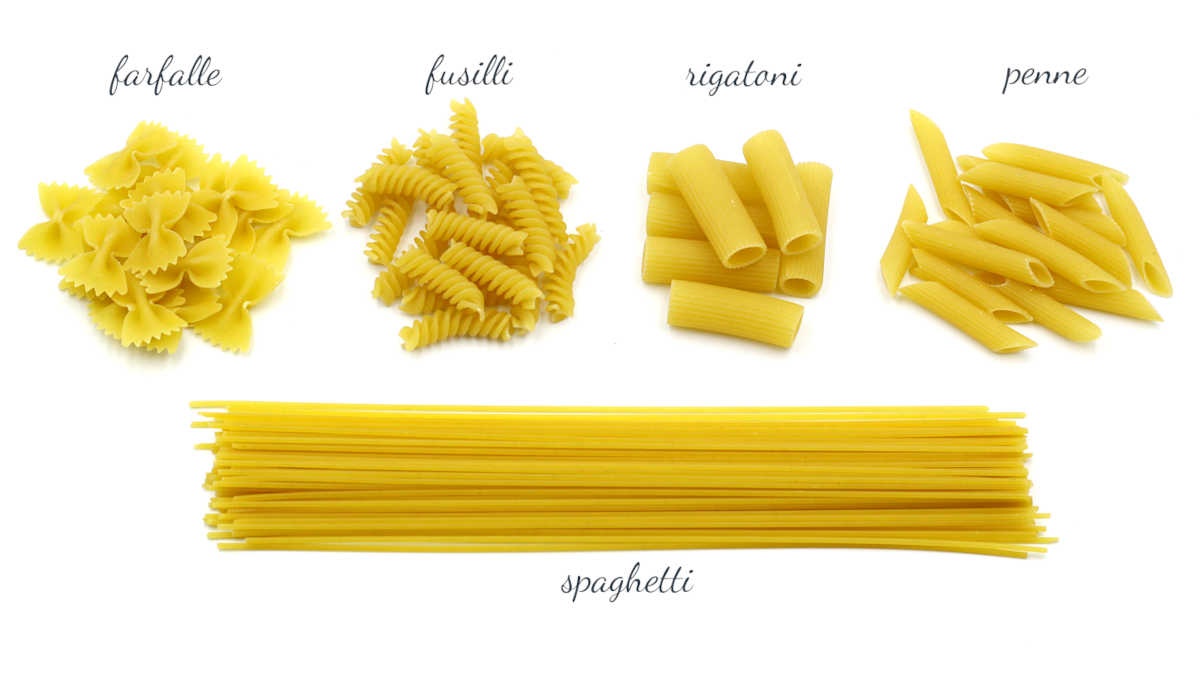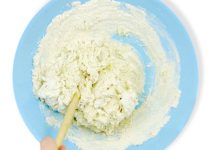If you’re looking to buy and cook with the best Italian pasta brands, I would say that you’re clearly passionate about making the best pasta dishes that you can make at home.
When I don’t have any energy in the evening, I just need a few ingredients to make a tasty pasta dish: spaghetti, an amazing can of tomatoes or fresh San Marzano/Roma tomatoes, a couple cloves of garlic, olive oil, fresh basil, freshly ground black pepper, and parmesan cheese. If I’m in a spicy mood, I will add chili flakes, too.
All these are basic ingredients that I always make sure to have in the fridge and in my pantry. It’s as natural as always having a few types of flours in the house.
Some ingredients are quite expensive, like the olive oil and the parmesan cheese. However, they’re worth it. You can find so much joy in a dish that doesn’t take more than 20 minutes to make.
Contents
Best Italian Pasta Brands: Top Picks
1. Overall best: Barilla
I love the pasta from Barilla and, for me, they’re always going to be one of the best Italian pasta brands. I love the affordable prices, the varied selection, and the availability. You can be sure that you can find this brand anywhere. They’re not top-quality but they’re the best for meals on a budget.
2. Top quality: De Cecco
If you can spend a bit more, I totally recommend getting De Cecco over Barilla. Their quality is top-notch, no doubt about it.
Best Italian Pasta Brands: My Favorites

If we want to make delicious pasta dishes, we must find the best Italian pasta brands. Who better than those who actually invented some of the most popular dishes on the planet?
Next to pizza, pasta is reigning at the top of favorite foods for a lot of us, whatever culture we come from.
The best Italian pasta brands are:
- Barilla – maybe not the absolute best but still good enough and one of the cheapest and with a strong presence globally, I highly recommend it if you are on a budget
- De Cecco – the Italian pasta brand that many people consider it to be the best
- Rummo – a second favorite after De Cecco, their gluten-free pasta is highly praised, too
- La Molisana – in the same range as De Cecco and Rummo, it’s very hard to choose a clear winner between these three
- Rustichella d’Abruzzo – artisan pasta, expensive and mind-blowing
- Benedetto Cavalieri – slightly cheaper than Rustichella d’Abruzzo but still as impressive
- Morelli – the best Italian pasta brand if you’re looking for unique flavors or wonderful pasta shapes of the highest quality
1. Barilla: good quality & cheaper price
When I started cooking pasta at home, this was the first brand that I bought. I was in high school and I decided to make my first pasta dish at home by buying a box of spaghetti and a jar of pasta sauce. And that’s how I became hooked.
Maybe I’m biased but for me Barilla will always be one of the best Italian Pasta brands. They have never let me down, no matter what type of pasta I bought from them. And their cooking times are spot on.
Plus, it’s also one of the most popular pasta brands around the world. The quality we get for the price is just perfect and that’s what makes it so popular in many countries.
Well, according to NY Times, Barilla is also the most popular dried pasta in Italy. Reading that article, we also discover that Italians average 60 pounds of pasta per year. Eating 5 pounds of pasta per month seems extraordinary. I guess I’m just averaging half of that.
For Italians, most of the pasta consumed comes from a box. They call it pasta secca and we call it dried pasta or pasta in a box. Pasta fresca is not something that most regions in Italy bother with. The same goes for most restaurants.
Given the impressive quantity that they eat, who would have enough time to always make fresh pasta at home? It’s only logical that they cook with dried pasta from a box most of the time.
As it turns out, Italians know that if you buy from some of the best Italian pasta brands, you’ll get high quality products that can match or exceed the taste and deliciousness of pasta fresca.
How it’s made
For the classic pasta (spaghetti), these are the ingredients: semolina, durum wheat flour. There are also vitamins and minerals: vitamin B3, iron, vitamin B1, vitamin B2, folic acid.
Barilla pasta is made under rigid government controls.
It’s made from hard durum-wheat flour, semolina in English or semola di grano duro in Italian.
When we’re making fresh pasta at home, we use bread flour. However, hard durum-wheat is used for pasta in a box because it can withstand the pasta making and cooking, making it perfect for al dente cooking.
Besides the classic pasta, they also have:
- whole grain pasta – their whole grain spaghetti or penne are made from one ingredient: whole grain durum wheat flour
- organic pasta
- veggie spaghetti – these are made with purée obtained from spinach and zucchini but they still contain semolina and durum wheat flour, they’re a nice choice if you want to eat more vegetables and they have a green color but there’s pretty much no difference in taste from the regular pasta
- pasta made entirely from chickpeas or read lentils
- gluten-free pasta
Where to Buy?
Check Price and User Reviews Here
2. De Cecco: impressive quality
There are quite a few people who will argue that De Cecco is certainly better than Barilla, of a better quality. I won’t argue with that because it tends to be true.
If you didn’t like Barilla and you consider it to be mediocre, I recommend trying this brand as one of the best Italian pasta brands.
Given that De Cecco’s history starts in 1886, they’re just a few years younger than Barilla, which was founded in 1877. These two manufacturers, two of the biggest Italian pasta makers in the world, have withstood the test of time. Once you’ve tasted their pasta, you’ll understand why after the first bite.
The only way to describe De Cecco pasta is to say that it’s absolutely delicious. It’s got the perfect al dente texture and a rich flavor.
If you want to make pasta with brown butter and parmesan, this brand will provide you with the perfect spaghetti for it.
The recommended cooking time that’s written on the box perfectly matches the needed time for obtaining the perfect al dente texture.
Even so, I highly advise you to taste the pasta once the cooking time comes near completion. I don’t rely on cooking times. After so many years, it’s just instinct. But I still taste the pasta multiple times because if there’s one way to ruin the dish is to boil the pasta soft.
How it’s made
De Cecco informs us that they use only the best durum wheat from Italy, California and Arizona. The Italian wheat is chosen for its flavor and the California and Arizona wheat are chosen for the quantity and quality of the proteins.
That’s what makes their pasta al dente to be firm and elastic. The manufacturer claims that this is one of the features that distinguishes them from other brands.
The carefully selected wheat is grounded in their mill, to be able to guarantee fresh semolina all the time. They only use coarse grain semolina to avoid damaging the quality of the grains.
Last but not least, De Cecco pasta has a rougher texture, which is the result of the bronze-drawing process. The manufacturer continues to use bronze draw-plates because it’s the only way to make the pasta naturally rough.
This rough texture is what makes any type of sauce to coat the entirety of the pasta, guaranteeing perfect bites until the last one. This is the feature that defines De Cecco as one of the best Italian pasta brands without a doubt.
Last but not least, the drying is made under low temperatures. It’s a slow process that keeps the properties of the wheat intact.
De Cecco vs Barilla: Price
Some consider De Cecco to be quite expensive, about maybe 2-3 times more expensive than regular pasta.
It’s definitely more expensive than Barilla, which is considered a pretty cheap option and I totally agree.
There are people who say that there’s not a high price difference between these 2 famous manufacturers but I don’t see it that way. There’s a clear price difference. I guess it matters greatly where you live.
If you want to make a comparison and see if the higher price is worth it, just buy one box of each, use the same sauce on both and then you’ll know for sure if the cheaper option is good enough or if you’re willing to spend more to satisfy your tastes.
Moreover, there are some who get De Cecco only when it’s on sale and otherwise buy Barilla. I totally agree with this strategy. You can buy a bunch of boxes because it lasts a long time in the pantry.
Where to Buy?
Check Price and User Reviews Here
3. Rummo: delicious gluten-free pasta
When it comes to recommending the best Italian pasta brands, you’ll frequently hear the name Rummo. It’s really good.
Plus, it’s in the same price range as De Cecco. If you want something different that’s not too expensive, I recommend Rummo.
However, what do I love the most about this manufacturer?
I love that Rummo has some of the best gluten-free spaghetti and pasta in general. The gluten-free pasta is more expensive but if you’re eating a gluten-free diet, you should give these a try.
You can choose from gluten-free spaghetti, fusilli, rigatoni, penne, and elbows.
The ingredients for the GF pasta are: brown rice, yellow corn, white corn, rice, potato starch, mono-and-diglycerides of vegetable origin. They’re made in Italy.
They also have a selection of organic lentil chickpea elbows, organic lentil chickpea penne, organic red lentil rotini, and organic red lentil shells.
Both the regular and the gluten-free are awesome and people appreciate the high quality that this brand offers.
I love the wide selection that they offer for different diets.
Where to Buy?
Check Price and User Reviews Here
4. La Molisana: so many shapes
Another awesome Italian pasta manufacturer is La Molisana. I definitely recommend giving this a try.
Their prices are pretty much in the same range as De Cecco and Rummo. In terms of quality they’re also closely matched. I will admit that I don’t notice a difference in quality when it comes to these three manufacturers.
The ingredients for their classic pasta are: durum wheat, semolina, folic acid, niacin, iron lactate, thiamin mononitrate, riboflavin.
If I’m in the mood for something different, I love cooking with La Molisana Spaghetti al nero di seppia. They don’t taste different but they do make a striking visual impression.
They also have a lot of whole grain and gluten free options.
Overall, they have one of the most varied shape selections.
Where to Buy?
Check Price and User Reviews Here
5. Rustichella d’Abruzzo: restaurant-level quality
If you want to elevate your pasta dish to match the dishes served by the best restaurants, you should give this manufacturer a chance to help you achieve that.
What’s so special about Rustichella d’Abruzzo?
This is actually artisan dried pasta crafted in Abruzzo. Just like we have artisan breads, we also have artisan pasta.
The ingredients are: durum wheat semolina and water.
It’s made from top-quality flours and pure Apennine mountain spring water.
In order to ensure the highest quality, the pasta is extruded through bronze dies for a slightly rugged texture that ensures that plenty of sauce sticks to each pasta.
Moreover, this is air-dried. None of the above best Italian pasta brands have retained this part of the manufacturing process.
The bad part about all of this?
The price is really expensive. I think you could probably buy 3 or 4 De Cecco boxes for the price of 1 Rustichella d’Abruzzo.
If it’s within your budget, definitely give this artisan pasta a try, at least once to see if it really is that special and impressive.
Those who have tried it, agree that it’s far superior to regular dried pasta that we find in our local stores.
Where to Buy?
Check Price and User Reviews Here
6. Benedetto Cavalieri
Just like Rustichella d’Abruzzo, this pasta is also special. Fortunately, it is slightly more affordable than our other artisan pasta brand but not by much.
It’s just as outrageously expensive and just as outrageously delicious.
The pasta is made with durum wheat semolina from Southern Italy. The process of selecting the best wheat, includes using the durum wheat that’s cultivated on the hills of Apulia and Basilicata, which is grown without the usual massive use of chemical fertilizers.
This manufacturer also uses a processing method called ‘Delicate’. It involves long kneading, slow pressing, drawing and drying at a low temperature. All this is done to preserve the taste and typical flavor and to ensure a completely natural consistency.
They still use molds made by a special bronze alloy.
Where to Buy?
Check Price and User Reviews Here
7. Morelli: unique taste
This Italian brand is another example of expensive pasta. It also offers an impressive collection. Their flavored pasta sounds awesome.
As a manufacturer, Morelli prides itself on using the artisanal method of reincorporating wheat germ into semolina.
Thus, they create a pasta with a unique taste and aroma of wheat.
It also results in a dense pasta that is able to absorb sauces well.
Like they say, their pasta is something else.
Their egg tagliolini certainly fits that description. But so do other types like: lemon pepper pasta, truffle linguine, garlic and basil linguine, squid ink linguine, olive fettuccine, etc. They do love their flavored selections.
The gluten free and whole wheat offerings are just as delicious.
Where to Buy?
Check Price and User Reviews Here
The most popular pasta shapes
We’ve talked about the best Italian pasta brands, now let’s talk shapes. I’ll only cover them in a few sentences because I don’t want to bore you. We just need to know the fundamentals.
For example, I love penne for Bolognese but sometimes I love switching it up with rigatoni.
Penne and rigatoni have those ridges running along the surface, which makes them perfect for chunky sauces. These 2 can also be paired with large pieces of vegetables. Penne work for salads perfectly, too.
Tagliatelle also work nicely for Bolognese. Actually, in Bologna, ragu is traditionally served with tagliatelle that are made with eggs and soft wheat flour.
Pappardelle and fettuccine are two other pasta shapes that pair well with ragu.
For a simple tomato sauce, I’ll always choose spaghetti, spaghettoni, linguine or bucatini. These 2 are iconic for lighter, simpler sauces, like marinara sauce. The sauce won’t adhere as well to their surface because they’re smooth.
Fusilli is another favorite pasta shape in Italy. I will admit that I don’t cook as often with them. They’re nice for meat or ricotta-based sauces and they can also look awesome in salads.
In salads, I prefer fusilli more than penne.
If I want to make something cute, I cook with farfalle.
I don’t like angel hair, it’s my least favorite. That’s because I enjoy a more robust and chewier taste. Angel hair can be a nice option for light cream sauces and seafood. If you enjoy eating delicate sauces, this can be a good choice for you.
All of the above recommendations for the best Italian pasta brands cover all these shapes and pasta types, including gluten-free options.











